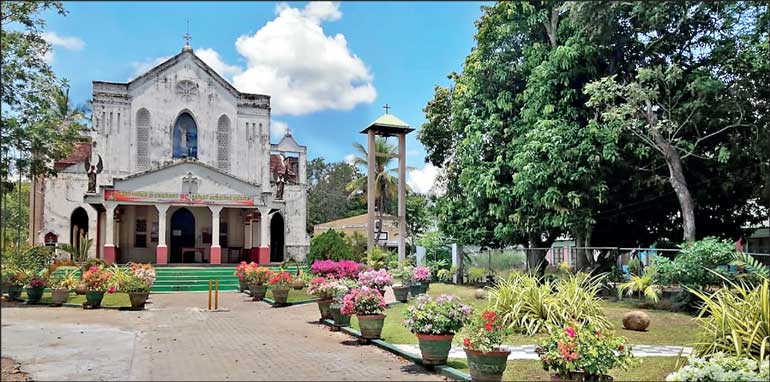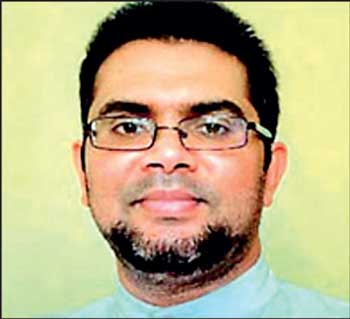Tuesday Apr 15, 2025
Tuesday Apr 15, 2025
Saturday, 18 December 2021 00:01 - - {{hitsCtrl.values.hits}}

Christ the King Church, Hingurakgoda
By Fr. Rashmi Madusanka Fernando
Christmas carols in Bana Shalawa
In September 2017, the Hingurakgoda church had an issue finding a place to have its annual Christmas carols. As it had usually been done in the past the next-door school hall had become a no-entry zone for us because of its preoccupation with the GCE O/L exam preparations. Christmas was approaching and the children in the church were getting ready for their big day of the year.
It was during this time that I paid a visit to the Hingurakgoda Buddhist temple as it was customary for me to visit the chiefs of co-denominations at the locality wherever I am, especially during the time of Christmas. This, I believe, is something that my family upbringing has bestowed on me. It is because at home we have been trained from our childhood to share food with our neighbours irrespective of their faiths, religions, beliefs, etc. during the time of Christmas and the Sinhala Tamil New Year.
In my conversation with the chief monk that day, it happened that the issue of the concert hall that the church was facing popped out of my mouth. “Don’t worry Father. You can come and have the concert in the bana shalawa (temple hall). And for your tea, I will arrange fish buns for everybody. How many of you?” I became speechless.
With joy, I came back to the church and recounted the good news to the church congregation and felt relieved. But there was a concern. “Father, what about that huge Buddha statue kept on the stage of the bana shalawa?” asked a person of mixed marriage who was familiar with both the environments in the temple as well as in the church. “Will not Lord Buddha be happy to see our children singing, dancing, performing, and shouting on the stage?” I asked. “But Father, we have to make the crib there as well,” another added. “True, we’ll make it. I think it’s not that Lord Buddha and Jesus cannot live together on the same platform. Rather, it is we who cannot see them living together, not only on the stage but also in our day-to-day lives.”
I was determined.
 It wasn’t however the first encounter I have had with the chief monk of the Hingurakgoda temple. Before that day, we have had on several occasions visited each other, during the time of the annual temple perahera (procession), Sinhala and Tamil New Year, Avurudu festivals, etc. with mutual support and invitations.
It wasn’t however the first encounter I have had with the chief monk of the Hingurakgoda temple. Before that day, we have had on several occasions visited each other, during the time of the annual temple perahera (procession), Sinhala and Tamil New Year, Avurudu festivals, etc. with mutual support and invitations.
While it has been the tradition of the Youth Association of the church to organise a dansala (almsgiving) during the time of perahera and on the day of Vesak, during the year of my stay in Hingurakgoda, the same dansala was conducted, but differently, in the form of shramadana launched to plant flag poles along the main street of the perahera. The young novices of the Jesuit Order who happened to be in the church at that time for their pastoral experiment participated in this.
Rice, seasons and life
The agricultural landscape in Hingurakgoda in the ancient waw badi rajye (kingdom of tanks) of Rajarata is seasonal. However, these seasons I found were not according to how they are being considered in Europe, or America or elsewhere in the world. Rather, they were based on the rhythm of the activities attached to people’s main occupation – rice cultivation.
When the fields were getting ready for sowing, it is the season of hard labour, ploughing, and tilling the ground which I would call the grey season after the colour of the fields, the colour of the ploughed earth. During this season, it is often hard to find men regular in the church or the temple.
Then comes the vegetative phase of the rice plants which, according to me, is the green season, again after the colour of the fields. It involves relatively less labour and, hence, more time for one’s personal, familial, social, and worship activities such as Sunday mass, temple rituals, etc.
The following season, according to me, is the blue season characterised by the reproductive phase of the rice plants. It is blue because of the anxiety that the season brings in. People are anxious during this stage of the rice plants as to whether or not they would open up, or be attacked by the insects, or destroyed by the elephants, or supported with enough and regular water supply, etc.
In short, during this season, they are anxious about protecting what they have laboured for and maximising the gain. It has been my experience in the church that the adults are often reluctant to commit themselves to common responsibilities during this season because they need time for themselves to deal with the anxieties of life.
Finally comes the harvest time or the golden season, named once again after the very colour of the fields. It is during this season that one generally sees many smiling faces, loud talking of people, the town becoming increasingly active, people getting organised, family events, communal functions, and village carnivals are being organised, and the church and the temple getting crowded.
 Thus, the seasons of life associated with the rhythm of people’s major livelihood in Hingurakgoda have a direct and significant influence on their religious observances and adherence to faith-related activities, thus witnessing the age-old symbiotic system of living in Sri Lanka known as ‘Gamai, Pansalai, Wewai, Dagabai’ (village, temple school, tank, shrine). It was indeed important for me to be aware of the dynamics of these seasons to understand why people in Hingurakgoda behaved the way they did whether in the church, or the temple, or elsewhere in
Thus, the seasons of life associated with the rhythm of people’s major livelihood in Hingurakgoda have a direct and significant influence on their religious observances and adherence to faith-related activities, thus witnessing the age-old symbiotic system of living in Sri Lanka known as ‘Gamai, Pansalai, Wewai, Dagabai’ (village, temple school, tank, shrine). It was indeed important for me to be aware of the dynamics of these seasons to understand why people in Hingurakgoda behaved the way they did whether in the church, or the temple, or elsewhere in
the village.
Finally, one of the unifying factors I have experienced among people of Hingurakgoda is their augmenting willingness to coexist with other faiths within and outside marriage which is nonetheless not without troubles altogether. While visiting families and attending the funerals of both Catholics as well as Buddhists of the place, I had ample opportunities to experience their harmonious living, collective struggles, difficulties and pains, as well as joys in life.
I still remember the day when the parishioners came to know about my living in the lagum ge without a cook after the sudden death of that Upasaka Thaththa as described last week. The ones who became increasingly troubled upon realising it, if I am not mistaken, were those in mixed marriages who got themselves hurriedly organised to bring meals to the church.
(Fr. Rashmi Madusanka Fernando, SJ is a Jesuit Priest in the Society of Jesus, Sri Lanka, and the present Director of Satyodaya Centre for Social Research and Encounter, 30, Pushpadana Mawatha, Kandy 20000, Sri Lanka. Contact: [email protected])
Discover Kapruka, the leading online shopping platform in Sri Lanka, where you can conveniently send Gifts and Flowers to your loved ones for any event including Valentine ’s Day. Explore a wide range of popular Shopping Categories on Kapruka, including Toys, Groceries, Electronics, Birthday Cakes, Fruits, Chocolates, Flower Bouquets, Clothing, Watches, Lingerie, Gift Sets and Jewellery. Also if you’re interested in selling with Kapruka, Partner Central by Kapruka is the best solution to start with. Moreover, through Kapruka Global Shop, you can also enjoy the convenience of purchasing products from renowned platforms like Amazon and eBay and have them delivered to Sri Lanka.
Discover Kapruka, the leading online shopping platform in Sri Lanka, where you can conveniently send Gifts and Flowers to your loved ones for any event including Valentine ’s Day. Explore a wide range of popular Shopping Categories on Kapruka, including Toys, Groceries, Electronics, Birthday Cakes, Fruits, Chocolates, Flower Bouquets, Clothing, Watches, Lingerie, Gift Sets and Jewellery. Also if you’re interested in selling with Kapruka, Partner Central by Kapruka is the best solution to start with. Moreover, through Kapruka Global Shop, you can also enjoy the convenience of purchasing products from renowned platforms like Amazon and eBay and have them delivered to Sri Lanka.